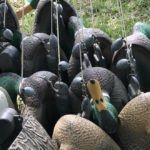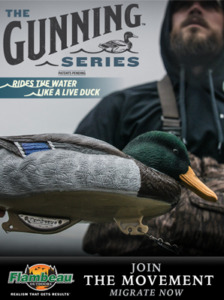Building your duck decoy spread in the off-season
The pursuit of duck hunting is full of equipment and tools that may seem intimidating to a new hunter. From calls to waders, duck hunters often have strong and varying opinions on what equipment is best, what equipment isn’t worth the money, and everything in between. This goes double for duck decoys.
First, it should be said (and very clearly) that whatever legal methods and equipment that work for you–and you prefer–are fine. This goes for shotguns, shells, camouflage, and your decoys. Duck decoys are perhaps one of the most loved yet hated pieces of equipment in the waterfowling world. Every waterfowler loves the experience of watching ducks cup up and commit to a carefully set decoy spread. And we all hate tangled messes of decoy lines and weights hanging off of leaky decoys with chipped paint stuffed into a mesh bag, creating a level of frustration all its own.
Let’s take a look at duck decoy basics, considerations for a new hunter, and some truths about duck decoys taken from decades of experience in the field.
Puddle Ducks
For the purposes of this how-to we will consider puddle duck hunting. Puddle ducks, or dabbling ducks, are the most commonly pursued duck by hunters in North America. Found in all four North American flyways, puddle ducks include popular species such as wigeon, gadwall, teal, pintail, northern shoveler, wood duck, and the ever popular mallard.
Other types of ducks that are no less sporting but perhaps lacking in their popularity behind puddle ducks include diver ducks and sea ducks. It’s worth mentioning that many ringneck ducks, canvasbacks, scaup, and redhead diver ducks have fallen in a spread of puddle duck decoys, thus providing the basis for an argument that the most effective decoy spread for fresh water waterfowlers is one made up of dabbler duck decoys. There certainly is no harm in adding a few diver duck decoys to the outside edge of your mallard spread in hopes of a mixed bag.
Choosing Duck Decoys
The off-season is the perfect time to do some research and decide which decoys to put to work on opening day. There are many factors to consider that may not be top of mind in the warm days of summer, but can make a big difference this season when those cold fronts start to push birds into your area. Here are a few things to keep in mind.
Decoy Species and Gender
For most hunters, the image of a mallard drake decoy with an iridescent green head is what duck decoys are all about, and there is no doubt that fully plumed mallard drake decoys are effective. For the most part mallard ducks are social, vocal, and a steady bellwether for the hunting in an area.
When building a dabbler duck spread, starting with mallards is a fantastic way to go. New decoys are often sold in packs of a dozen. Generally speaking they will run half drakes and half hens. While it may seem like a better idea to run only drake decoys for their eye catching bright colors, consider that in early season the drake’s plumage is not nearly as pronounced in color, and in late season the biology of the breeding season may make a hen decoy much more enticing. There is some theory that in the late season, six or eight hen decoys mixed with only two or three mallard drake decoys may be more effective than drake decoys alone.
Other decoys that can bring a lot of character and realism to your spread might include a four pack of green-winged teal or wigeon, and maybe a pair of pintails. By mixing in two or three other species in a limited number, your spread can become more inviting to a larger variety of ducks and give a more realistic impression of migrating birds.
Plastics, Rubber, or Foam-Filled Decoys
The decoy construction material can play a number of factors when it comes to the hunt as well as off-season storage. Although early decoys were made of things like cork or wicker, contemporary decoys utilize modern materials like plastics and rubber.
Different materials have a variety of pros and cons. Take into consideration the durability of the material, not only of the decoy itself but also the paint, keel, and where the decoy line is designed to attach. Spending hard-earned money on decoys that crack, leak, or have their weight attachment points split in a season or two can be disheartening. Foam-filled decoys take the risk out of leaky decoys, but you sacrifice weight and portability. Hard plastics are durable but can become brittle in frigid temperatures. No matter what type of decoy you choose, give careful consideration to the durability of the paint and finish.
Choosing Decoy Weights, Lines, and Rigs
Duck decoys must be rigged with some type of weight and line to keep them tethered when you place them into a body of water, preventing them from floating away. When choosing the type of decoy line and weight rigs, there are a few factors to consider:
- Typical Hunting Location – If you’re primarily hunting shallow marshes with flooded vegetation, small ponds, sloughs, or other shallow water with flooded vegetation, chances are you can get away with shorter rigs and lighter weights. Texas rigs work great in this situation.
- Wind and Current – High winds and strong currents will play havoc on light decoy weights and short lines. These situations call for heavier anchors and longer cables or cords. Late season hunts over swift water require longer decoy line lengths to keep from pulling the front of your decoys down into the water. Strong wind currents on larger bodies of water can be problematic, especially on hard bottom areas where a lighter weight won’t hold. If you plan on hunting large reservoirs, consider heavier decoy anchors–6 or 8 ounces of weight should hold.
- Water Depth – Puddle ducks typically frequent waters that could be considered just that: “puddles.” However, you may also find yourself hunting over deeper water, perhaps a channel through a reservoir, or a steep-sided creek or river. Deep water hunts call for longer lines, usually wrapped around the keel and attached to a heavy weight.
Decoy Weight and Line Styles
Decoy line and weights, or “rigs,” can be as simple as a section of cord and a fishing sinker, and as complicated as any variety of jerk line made to add motion to your spread. For simplicity, let’s focus on the two main types of decoy rigs.
Texas Style Decoy Rigs
Texas rigs consist of a length of solid vinyl cord or vinyl coated steel cable with a loop on one or both ends and a sliding weight of 4 ounces or more. For the best action on the water, Texas rigs can be attached to decoys with large surf swivels that slide up and down the cable length, allowing the decoy to swivel on the water’s surface with just a slight breeze.
Texas rigs are convenient, easy to store, and are known for their ability to remain untangled in the bottom of a boat, the back of your truck, or when in storage. This style of rig really shines when it’s time to pick up decoys. Gripping the duck decoy by the neck or the head, lift it out of the water and clip the top loop onto a carabiner. Texas rigs allow you to pick up decoys quickly, often without even getting your hands wet!
Keel Line Rigs
The traditional keel line decoy rig is simple and effective. A line or cord is attached to the decoy keel either directly with a knot or with a swivel for more action. Cut the cord to the length of the deepest water you plan on hunting and tie a weight on the opposite end; it’s as simple as that.
Strap weights or long stem mushroom weights work well for this type of decoy rig. To pick up and store keel line rigged decoys, you lift the decoy out of the water, wrap the line around the keel, and ideally bend the soft lead strap over the end of the keel to hold everything in place. Keel line rigs work well over deeper water where Texas rigs can be impractical; they do, however, have more of a tendency to get tangled in storage.

Your Style of Duck Hunting
We’ve discussed considerations when it comes to the type of ducks you intend to imitate in your decoy spread, the right materials for decoy construction, and how to rig your decoys to an anchor. But what is the right decoy setup for your style of hunting?
There are several elements to consider when it comes to the best duck decoys for your spread selection: hunting style, hunting location, and conveyance to and from the blind.
Decoy Weight – Are you a pack-in, public marsh hunter, or are you excited to get after the ducks at a private spot with vehicle access to the blind? The weight and size of your decoys play a vital role in your ability to be mobile. When it comes to out-of-the-way spots in a marsh or a pond, sometimes less is more, and having the flexibility to move and adjust is more critical than a large spread of decoys. Lighter decoys allow you to be more mobile and pack farther from crowded areas of public hunting spots. Bigger, heavier decoys are often more durable and may take more abuse.
Mobility – For the hunter with mobility in mind, look for slightly smaller decoys that are lighter weight. If you’re hunting in shallow flooded vegetation such as a marsh, you can often get by with just 2 ounces of weight on Texas rigs. Some decoys are even marketed as packable, allowing for a certain amount of deflation when you’re packing everything up. Be careful about weak or complicated valve systems, and imagine yourself thigh-deep in a cold December marsh trying to inflate or deflate decoys with numb fingers. Mixing in smaller teal decoys with half a dozen mallard decoys can give your spread a bigger look while saving on space and weight.
Larger Spreads – Maybe you’ve got some great private access where an ATV or even a pickup can drive right down to the blind. Duck hunting lends itself well to creature comforts like blind heaters, comfy chairs, and even camp stoves for coffee and breakfast if you are fortunate enough to have access to the right location. For this type of hunter, large spreads of heavy decoys are not an issue. Consider magnum type decoys for better visibility from passing bird and foam-filled decoys for their durability. Rigging with heavy 6 or 8 ounce weights will ensure your decoys will remain in place even in gusty winds and big waves.
Conveyance – How do you plan to transport your decoys to your hunting spot? Some options include a decoy bag over your shoulder, a cart, a sled pulled by hand or an ATV, or maybe you plan to use a boat or a kayak. Remember, decoys are only part of the gear you’ll need for the hunt. Piling decoys on top and around your shotgun, blind bag, and possibly your duck dog in a canoe, kayak, or boat can be interesting. Keep your planned mode of transportation in mind when you’re deciding which decoys, and how many, to take into the field next season.
Final Thoughts
Duck hunting is full of tradition and heritage, including the use of decoys. From ultra-realistic fully flocked decoys, to hand carved and painted works of art, choosing the right decoys and decoy rigs for your spread is a personal decision. One thing is for certain, though: you can never have enough decoys!
Last modified: July 19, 2022














0 Responses to :
How to Select the Right Duck Decoys